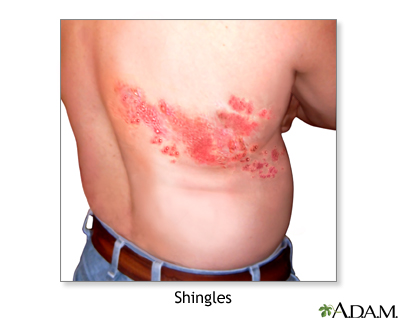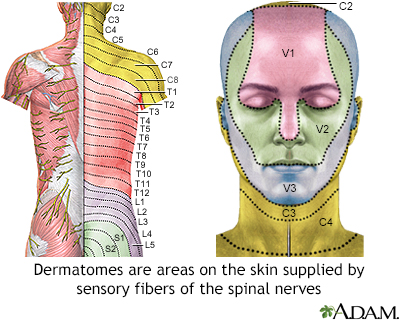Shingles
Shingles is a painful, blistering skin rash. It is caused by the varicella-zoster virus, a member of the herpes family of viruses. This is the virus that also causes chickenpox.
Chickenpox
Chickenpox is a viral infection in which a person develops very itchy blisters all over the body. It was more common in the past. The illness is ra...

Shingles - Animation
The same virus that made you itch and scratch from chickenpox when you were a child can come back to haunt you when you get older. You’ll know it’s come back by the painful, blistery rash it leaves on your skin. Shingles is caused by the varicella-zoster virus, the same virus that’s responsible for chickenpox. Before there was a vaccine to prevent chickenpox, it was a very common childhood illness. After you have chickenpox, the virus can lie hidden in your body for years. Then when you get older, it can become active again. This time it’s called shingles, not chickenpox. Doctors don’t really know why the shingles virus reappears in some people but not others. But if you’re over age 50 or you have a weak immune system, your risk of getting the disease is higher. You can tell that it’s shingles by the red, blistery patches on your skin, especially if you had chickenpox when you were young. Usually the rash is focused on your trunk area around your back, belly, and chest, but you may also have blisters on your face. It will probably hurt, tingle, or burn, sometimes even before there is a rash. When the blisters break open, they’ll dry out and form crusts. If you do have shingles, your doctor may prescribe an antiviral drug like acyclovir, famciclovir, or valacyclovir. These drugs fight the virus that causes shingles, but you need to start taking them within 24 hours after you start feeling the pain and burning of the rash for them to be effective. You may also get medicines to reduce swelling and relieve itching and pain. To ease really bothersome itching at home, soak in a soothing bath, warm bath, or gently rub calamine lotion on your skin. Most cases of shingles clear up within a couple of weeks. Sometimes, though, shingles can leave behind permanent nerve damage, called postherpetic neuralgia. The good news about shingles is that once it clears up, it’s usually gone for good. But the pain, and nerve damage it causes, can sometimes linger. And if you’ve had shingles and your pain isn’t subsiding or your rash isn’t clearing up, call your doctor. To avoid getting shingles, stay away from anyone who has either shingles or chickenpox, especially if you’ve never had chickenpox before. And consider getting vaccinated against the varicella-zoster virus if you’re over age 50.
Causes
After you get chickenpox, your body does not get rid of the virus. Instead, the virus remains in the body but is inactive (becomes dormant) in certain nerves in the body. Shingles occur after the virus becomes active again in these nerves, often after many years. Many people had such a mild case of chickenpox that they do not realize they have had the infection.
The reason the virus suddenly becomes active again is not clear. Often only one attack occurs.
Shingles can develop in any age group. You are more likely to develop the condition if:
- You are older than age 60 years
- You had chickenpox before age 1
- Your immune system is weakened by medicines or diseases
If an adult or child has direct contact with the shingles rash and did not have chickenpox as a child or get the chickenpox vaccine, they can develop chickenpox, not shingles.
Chickenpox vaccine
All content below is taken in its entirety from the CDC Chickenpox Vaccine Information Statement (VIS): www. cdc. gov/vaccines/hcp/current-vis/varice...

Symptoms
The first symptom is usually pain, tingling, or burning that occurs on one side of the body. The pain and burning may be severe and are usually present before any rash appears.

Shingles
Shingles, or herpes zoster, is caused by the same virus that causes chickenpox. The virus can lie dormant in the body for many years and re-emerge as shingles. Shingles appear as a painful rash. It consists of red patches of skin with small blisters (vesicles) that look very similar to early chickenpox. Shingles usually clears in 2 to 3 weeks and rarely recurs.
Red patches on the skin, followed by small blisters, form in most people:
- The blisters break, forming small sores that begin to dry and form crusts. The crusts fall off in 2 to 3 weeks. Scarring is rare.
- The rash usually involves a narrow area from the spine around to the front of the abdomen or chest.
- The rash may instead involve the face, eyes, mouth, and ears.

Herpes zoster (shingles) on the neck and cheek
This is a picture of herpes zoster (shingles) on the neck and cheek. Shingles are caused by the same virus that causes chickenpox. Outbreaks of shingles often follow the distribution of nerves in the skin. This distribution pattern is called a dermatome (see the dermatomes picture).
Other symptoms may include:
- Fever and chills
- General ill feeling
General ill feeling
Malaise is a general feeling of discomfort, illness, or lack of well-being.
 ImageRead Article Now Book Mark Article
ImageRead Article Now Book Mark Article - Headache
- Joint pain
- Swollen glands (lymph nodes)
Swollen glands
Lymph nodes are present throughout your body. They are an important part of your immune system. Lymph nodes help your body recognize and fight germ...
 ImageRead Article Now Book Mark Article
ImageRead Article Now Book Mark Article
You may also have pain, muscle weakness, and a rash involving different parts of your face if shingles affects a nerve in your face. The symptoms may include:
- Difficulty moving some of the muscles in the face
- Drooping eyelid (ptosis)
Drooping eyelid
Eyelid drooping is excess sagging of the upper eyelid. The edge of the upper eyelid may be lower than it should be (ptosis) or there may be excess b...
 ImageRead Article Now Book Mark Article
ImageRead Article Now Book Mark Article - Hearing loss
- Loss of eye motion
- Taste problems
- Vision problems
Exams and Tests
Your health care provider can make the diagnosis by looking at your skin and asking about your medical history.
Tests are rarely needed, but may include taking a skin sample to see if the skin is infected with the virus.
Blood tests may show an increase in white blood cells and antibodies to the chickenpox virus. But blood tests cannot confirm that the rash is due to shingles.
White blood cells
A WBC count is a blood test to measure the number of white blood cells (WBCs) in the blood. It is a part of a complete blood count (CBC). WBCs are a...

Treatment
Your provider may prescribe a medicine that fights the virus, called an antiviral medicine. This medicine helps reduce pain, prevent complications, and shorten the course of the disease.
The medicines are most effective when started within 72 hours of when you first feel pain or burning. It is best to start taking them before the blisters appear. The medicines are usually given in pill form. Some people may need to receive the medicine through a vein (by IV).
IV
Intravenous means "within a vein. " Most often it refers to giving medicines or fluids through a needle or tube inserted into a vein. This allows th...
Read Article Now Book Mark ArticleStrong anti-inflammatory medicines called corticosteroids, such as prednisone, may be used to reduce swelling and pain. These medicines do not work in all people.
Other medicines may include:
- Antihistamines to reduce itching (taken by mouth or applied to the skin)
- Pain medicines
- Zostrix, a cream containing capsaicin (an extract of pepper) to reduce pain
Follow your provider's instructions about how to care for yourself at home.
How to care for yourself at home
Shingles is a painful, blistering skin rash that is caused by the varicella-zoster virus. This is the same virus that causes chickenpox. Shingles i...
Read Article Now Book Mark ArticleOther measures may include:
- Caring for your skin by applying cool, wet compresses to reduce pain, and taking soothing baths
- Resting in bed until the fever goes down
Stay away from people while your sores are oozing to avoid infecting those who have never had chickenpox -- especially pregnant women.
Outlook (Prognosis)
Shingles usually clear in 2 to 3 weeks and rarely returns. If the virus affects the nerves that control movement (the motor nerves), you may have temporary or permanent weakness or paralysis.
Sometimes the pain in the area where the shingles occurred may last from months to years. This pain is called postherpetic neuralgia.
Postherpetic neuralgia
Postherpetic neuralgia is pain that continues longer than a month after a bout of shingles. This pain may last from months to years. Shingles is a p...
Read Article Now Book Mark ArticleIt occurs when the nerves have been damaged after an outbreak of shingles. Pain ranges from mild to very severe. Postherpetic neuralgia is more likely to occur in people age 60 or over.
Possible Complications
Complications may include:
- Another attack of shingles
- Bacterial skin infections
- Blindness (if shingles occur in the eye)
- Deafness
- Infection, including encephalitis or sepsis (blood infection) in people with a weakened immune system
Encephalitis
Encephalitis is irritation and swelling (inflammation) of the brain, most often due to infections.
 ImageRead Article Now Book Mark Article
ImageRead Article Now Book Mark ArticleSepsis
Sepsis is an illness in which the body has a severe, inflammatory response to bacteria or other germs.
 ImageRead Article Now Book Mark Article
ImageRead Article Now Book Mark Article - Ramsay Hunt syndrome if shingles affect the nerves of the face or ear
Ramsay Hunt syndrome
Ramsay Hunt syndrome is a painful rash around the ear, on the face, or on the mouth. It occurs when the varicella-zoster virus infects a specific ne...
Read Article Now Book Mark Article
When to Contact a Medical Professional
Contact your provider if you have symptoms of shingles, particularly if you have a weakened immune system or if your symptoms persist or worsen. Shingles that affects the eye may lead to permanent blindness if you do not receive emergency medical care.
Prevention
Do not touch the rash and blisters on people with shingles or chickenpox if you have never had chickenpox or the chickenpox vaccine.
The shingles vaccine is different than the chickenpox vaccine. Older adults who receive the shingles vaccine are much less likely to have complications from the condition.
Shingles vaccine
All content below is taken in its entirety from the CDC Recombinant Shingles Vaccine Information Statement (VIS): www. cdc. gov/vaccines/hcp/current-...

Reviewed By
Jatin M. Vyas, MD, PhD, Professor in Medicine, Harvard Medical School; Associate in Medicine, Division of Infectious Disease, Department of Medicine, Massachusetts General Hospital, Boston, MA. Also reviewed by David C. Dugdale, MD, Medical Director, Brenda Conaway, Editorial Director, and the A.D.A.M. Editorial team.
Dinulos JGH. Warts, herpes simplex, and other viral infections. In: Dinulos JGH, ed. Habif's Clinical Dermatology. 7th ed. Philadelphia, PA: Elsevier; 2021:chap 12.
Whitley RJ. Chickenpox and herpes zoster (varicella-zoster virus). In: Bennett JE, Dolin R, Blaser MJ, eds. Mandell, Douglas, and Bennett's Principles and Practice of Infectious Diseases. 9th ed. Philadelphia, PA: Elsevier; 2020:chap 136.









 All rights reserved.
All rights reserved.